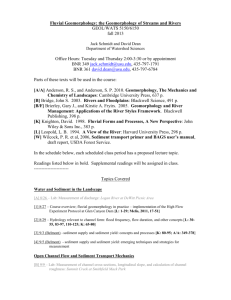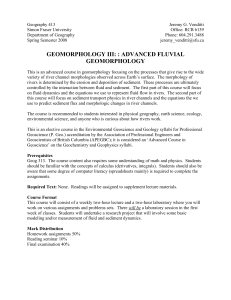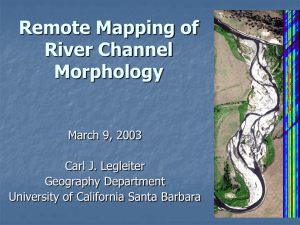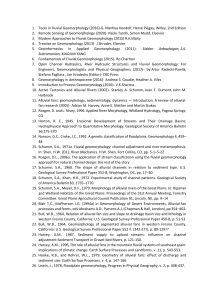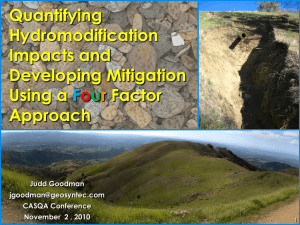Stream Geomorphology
advertisement
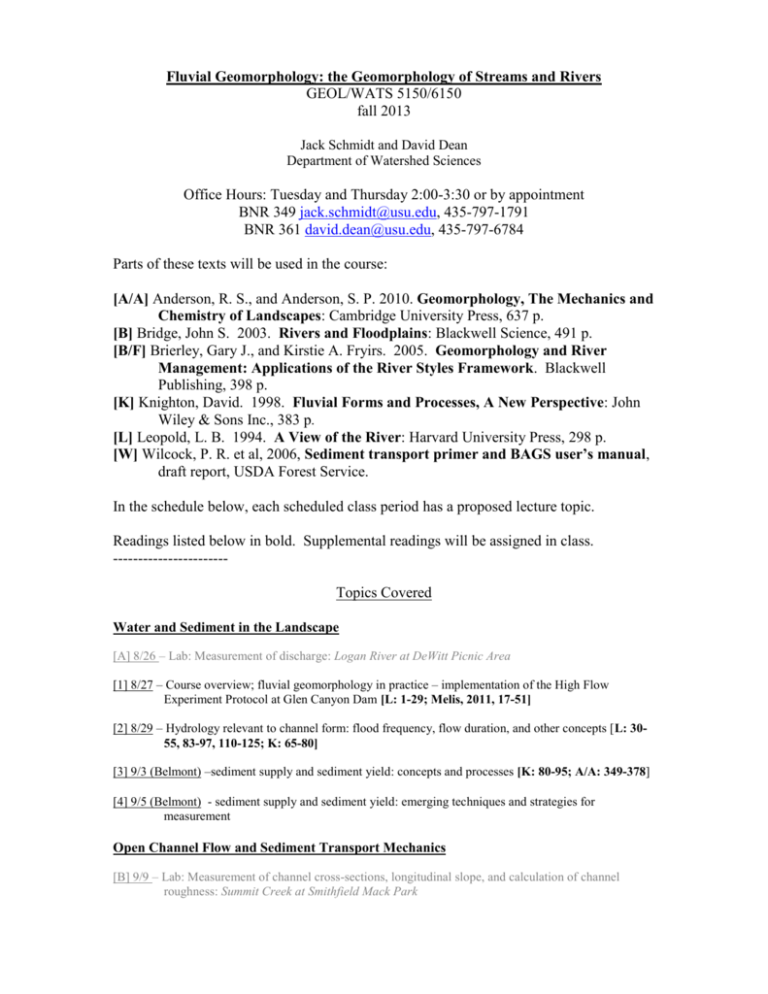
Fluvial Geomorphology: the Geomorphology of Streams and Rivers GEOL/WATS 5150/6150 fall 2013 Jack Schmidt and David Dean Department of Watershed Sciences Office Hours: Tuesday and Thursday 2:00-3:30 or by appointment BNR 349 jack.schmidt@usu.edu, 435-797-1791 BNR 361 david.dean@usu.edu, 435-797-6784 Parts of these texts will be used in the course: [A/A] Anderson, R. S., and Anderson, S. P. 2010. Geomorphology, The Mechanics and Chemistry of Landscapes: Cambridge University Press, 637 p. [B] Bridge, John S. 2003. Rivers and Floodplains: Blackwell Science, 491 p. [B/F] Brierley, Gary J., and Kirstie A. Fryirs. 2005. Geomorphology and River Management: Applications of the River Styles Framework. Blackwell Publishing, 398 p. [K] Knighton, David. 1998. Fluvial Forms and Processes, A New Perspective: John Wiley & Sons Inc., 383 p. [L] Leopold, L. B. 1994. A View of the River: Harvard University Press, 298 p. [W] Wilcock, P. R. et al, 2006, Sediment transport primer and BAGS user’s manual, draft report, USDA Forest Service. In the schedule below, each scheduled class period has a proposed lecture topic. Readings listed below in bold. Supplemental readings will be assigned in class. ----------------------Topics Covered Water and Sediment in the Landscape [A] 8/26 – Lab: Measurement of discharge: Logan River at DeWitt Picnic Area [1] 8/27 – Course overview; fluvial geomorphology in practice – implementation of the High Flow Experiment Protocol at Glen Canyon Dam [L: 1-29; Melis, 2011, 17-51] [2] 8/29 – Hydrology relevant to channel form: flood frequency, flow duration, and other concepts [L: 3055, 83-97, 110-125; K: 65-80] [3] 9/3 (Belmont) –sediment supply and sediment yield: concepts and processes [K: 80-95; A/A: 349-378] [4] 9/5 (Belmont) - sediment supply and sediment yield: emerging techniques and strategies for measurement Open Channel Flow and Sediment Transport Mechanics [B] 9/9 – Lab: Measurement of channel cross-sections, longitudinal slope, and calculation of channel roughness: Summit Creek at Smithfield Mack Park [5] 9/10 – Fundamental concepts in hydraulics [Wilcock lecture notes; W: 20-24; A/A: 381-395] [6] 9/12 (Wheaton) – Fundamental concepts in hydraulics [C] 9/16 – Lab: Field measurement of velocity profiles: East Fork Little Bear River near Avon [7] 9/17 – Drag partitioning; hydraulic geometry [L: 148-182; K: 171-186] [8] 9/19 – Sediment transport concepts [W: 1-20, 24-29; B: 44-49] [D, E] 9/21-- Field determination of the bankfull channel and bankfull discharge: Big Creek near Randolph (USGS gage 10023000) [9] 9/24 (Wheaton) – Incipient motion [W: 30-37] [10] 9/26 (Dean) – Bed material transport modeling [W: 38-51] [F] 9/30 – Lab: Field data useful in estimating bed entrainment and bed material transport: Cub River near Franklin [11] 10/1 – (Dean) Suspended sediment transport [B: 63-67] [12] 10/3 – Test 1: covers classes 1-10 River Character and Behavior [G, H, I, J] 10/4-6 – Lab: Rivers of the Colorado Plateau: Green River and San Rafael River near Green River [13] 10/8 – Bedrock channels [A/A: 422-449] [14] 10/10— Channel bed morphology: sand and gravel bedforms [B/F: 79-82; B: 78-139; K: 187-193] [15] 10/14 -- Channel bed morphology: sculpted geomorphic units [B/F: 82-86; K: 201-205] [16] 10/15-- Channel bed morphology: bars [B/F: 86-93; B: 141-147; K: 193-201] 10/17 – NO CLASS (Friday class schedule) [17] 10/24 (Dean) – Channel morphology [B/F: 104-108; B: 162-165; K: 165-187; L: 126-182] [K] 10/28 -- Calculating geomorphic change using digital elevation models: office [18] 10/29 (Dean) – Bank morphology and bank erosion [B/F: 93-104] [19] 10/31 (Belmont) – Floodplain forms and floodplain processes [B/F: 108-118; B: 260-327] [L, M] 11/2 – Lab: Application of geomorphology to the restoration of rivers: Provo River near Heber City [20] 11/4 (Brierley) – Systematic description of rivers within the River Styles Framework [21] 11/5 – Channel size [B: 165-180] [22] 11/7 -- Channel planform; controls [B/F: 118-120; B: 153-162; K: 205-213] [23] 11/11 – Channel planform: sinuous, single thread channels [K: 213-230; B: 181-199, 202-211] [24] 11/12 – Channel planform: multi-thread channels [K: 230-241; B: 199-202] [25] 11/14 (Belmont) – Longitudinal profiles at large and small scales [N] 11/18– Lab: Analysis of aerial photographs of channels and their changes: office [26] 11/19 -- Test 2: covers classes 11-20 THANKSGIVING BREAK [27] 12/2 (Wheaton) – Characterizing river behavior [B/F 143-185] [28] 12/3 -- Geomorphic responses to human disturbance [B/F: 208-239; K: 295-335] -----------------------------------------------TESTS (60%)– There will be three tests. There will be two in-class tests. The final test will be given at the time assigned by the university for final exams. All students will take the final at this time unless specifically arranged with the instructor. Each test is worth 20%. HOMEWORK ASSIGNMENTS (25%) – There will be homework assignments reviewing concepts discussed in class. These assignments will include computations, problems, and presentation, review, and discussion of journal papers. Homework assignments are sometimes assigned in conjunction with weekly assignments of the laboratory portion of the class. Grading – Typically, I assign grades on a curve. I award grades of “excellent” to students whose performance is in the highest category of students who take the class, averaged over the last several years. Typically, a few students earn this grade each year. Many students earn grades of “good”. Relatively few students typically earn grades of “average” or “poor.” FINAL PAPER (6150: 15%)-- Those students taking the class as 6150 are taking the class for graduate credit. Each of those students will write and prepare a 5-page literature review paper for a topic in fluvial geomorphology of relevance to their graduate research. The topic of this paper is to be approved by me by October 15. No less than 10 individual papers, or references, are to be assessed in the writing of this paper. For those undergraduate students who enroll in 5150, the unassigned part of your grade (15%) will be assigned based on your class participation.
